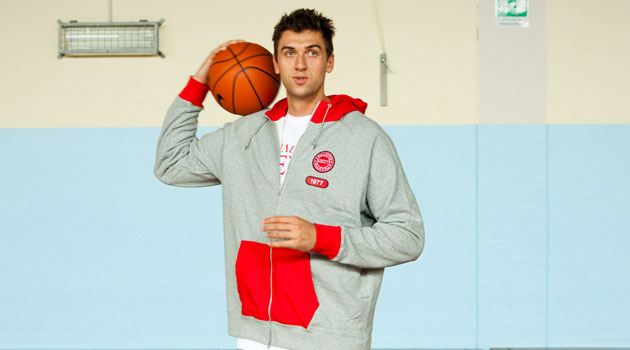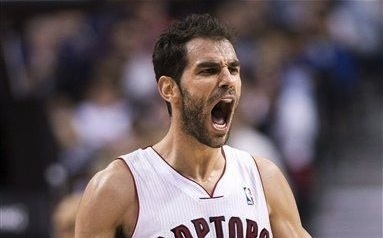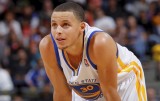
You might want to be sitting down for what I’m about to say, and I truly do hate to be the bearer of bad news but it has to be said: Andrea Bargnani’s help defense has not gotten better. Jay Triano says that the transformation of Bargnani to a good help defender will not be “overnight” and it’ll take some time. After four full seasons averaging 29 minutes a game the outlook isn’t optimistic, but I believe something can be salvaged of it.
Since the Raptors will be looking to force turnovers and tighten up their defense on the wings this year, it’ll mean that they’ll have to be finely in tune with each other when it comes to ball-deny-help concepts. In other words, they need to run a lot of shell drills. The general rule of thumb when playing this kind of defense is that if you’re one pass away from the ball you have to ‘deny’ the ball to your man, and if you’re two passes away, you’re responsible to ‘help’ in case the deny fails or some other calamity befalls the defense. In the Raptors’ case, this means that wings such as Barbosa, DeRozan and Weems will find themselves playing tight up at the top trying to deny passes from the point guard to the wings. This will naturally leave the Raptors bigs in a ‘help’ position where they must account for any intrusions to the rim.
The athleticism the Raptors possess at the wings is a starting point to play good defense but without the safety net of help defense it means nothing. Andrea Bargnani and Amir Johnson’s defense will be challenged quite a bit this year and they have to learn how to adequately perform the two tasks of playing big man defense. The first being preventing your man from getting a rebound while making sure you or your teammate secure it, and the second being knowing when to leave your man to deal with more urgent matters, usually a wing coming into the paint.
Bargnani has two major weakness on defense. First, he is too preoccupied with his own man and loses sight of his other responsibilities. This would be forgivable if he managed to shut his man down better and do his share on the glass, but since he doesn’t do that it makes it that much worse. Secondly, his defensive positioning makes his already poor peripheral vision even worse. He commits the cardinal sin of turning your back on the ball too often and all it takes is a split second for the entire situation to blow up in your face.
Getting Bargnani to be a good help defender in a zone situation is much easier than in a pressing situation. For example, in a 1-3-1 zone or a triangle-and-2 defense he can patrol a certain area of the court, have the entire offense in front of him and respond well to changes in the action. The “reading” he has to do will be minimized because his responsibility is narrowed. There’s still rebounding to worry about but let’s work under the assumption that his teammates will cover. Now, in a situation where he is concerned about his own man draining a jumper or posting him up and worried about helping, the equation gets trickier and he gets into trouble. How do we minimize this risk? Let’s think outside the box.
Force baseline and shorten rotation length: The debate between forcing baseline and forcing middle has been going on for ages. Proponents of forcing a player into the middle will argue that you want to send the offensive player where you are guaranteed your help will be; the other side of the argument is that the baseline and backboard are great defenders. In Bargnani’s case, his best help position is very likely the “low-post ball-side” where he can make a short rotation to seal the baseline on a driving guard. This would still require the “low-post weak-side” man to rotate to cover Bargnani’s man, but Johnson and Davis should be good at that. Obviously, this isn’t applicable in call cases but following it as a rule of thumb and recognizing when to switch to this kind of strategy can improve things.
Sag the strong-side wing: If the ball is on the strong-side wing and Bargnani is defending in the strong-side post, the Raptors can sag on the wing thus taking away the drive and also eliminating Bargnani’s need to help. As part of the risk and reward that basketball is all about, the Raptors could get in trouble if the wing is a good shooter. The best case scenario here is that the sagging combined with Bargnani’s post-defense (denial or front) will force the offense to swing the ball to the weak-side where better defensive options are available.
In a pressing defense, switch him to the three: Yes, you read that right. If the job is to deny the ball on the wing, use Bargnani’s best asset – his size and length – to do it. Teaching him how to play a couple angles on either wing has got to be easier than making him play interior defense which is accompanied by a great deal of responsibility. It sounds insane given his foot-speed compared to the threes in the league, but this can actually be of some use. The angles of denial are critical here, if he’s denying straight (staying perpendicular to the sideline) then Bargnani will get beat and the help defender will get called into question every time. If the denial is back-facing at an angle, then Bargnani has the man in front of him and has the advantage of size and span.
Hiding a 35-minute player on defense is difficult and Triano’s staff will have to get creative when dealing with Bargnani. As he said, it’s not going to happen “overnight” but there are things you can do to minimize the risk and avoid situations where he is called into action. Chalking bad defensive games up to “he’s got to get better” in the post-game interview is also a cop-out, instead of expecting Andrea Bargnani to play better defense, minimize the times he has to play defense. Easier said than done but you’ve got to play the hand you’re dealt.
Would like to hear your thoughts on how a team can hide weaknesses on defense.



